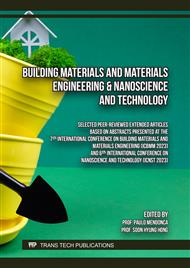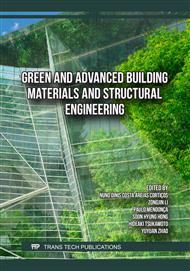p.3
p.11
p.17
p.25
p.33
p.43
p.49
p.55
Performance of Metakaolin-Based Geopolymer Incorporating Recycled Plastic Aggregate
Abstract:
Recently, research has been devoted to producing a more sustainable and environmentally friendly composite for substituting conventional cement concrete. This supports the global effort toward limiting the environmental impact of cement production. Geopolymer composites or alkali-activated materials have gained more attention within the research community due to the wide availability of waste (e.g., fly ash, slag) or natural (metakaolin, pozzolans) source materials suitable for geopolymer production. The present study investigates the potential of producing metakaolin-based geopolymer mortars with partial substitution of natural sand by recycled plastic fine aggregate (RPFA) to enhance composite sustainability. The primary variables of the experimental program include the percentage replacement of fine natural aggregate by RPFA (0, 10, 20, and 30% by volume). Tests comprising flowability, compressive strength, Flexural strength and unit weight of the various mixes were evaluated. The results indicated that replacing 10%, 20%, and 30% of sand with RPFA caused a reduction in the compressive strength by 10.6%, 21.8%, and 33.9% relative to the control mix. The flexural strength also decreased by 17.5%, 22.4%, and 30.4% compared to the control mix. Although substituting natural aggregate with RPFA reduced the mechanical properties, it improved the mix flowability by up to 20% relative to the control mix. Additionally, a reduction in the unit weight by up to 16.2% relative to the control mix was obtained, which offer a viable mean of producing lightweight mortar.
Info:
Periodical:
Pages:
17-23
Citation:
Online since:
December 2023
Authors:
Price:
Сopyright:
© 2023 Trans Tech Publications Ltd. All Rights Reserved
Share:
Citation:



